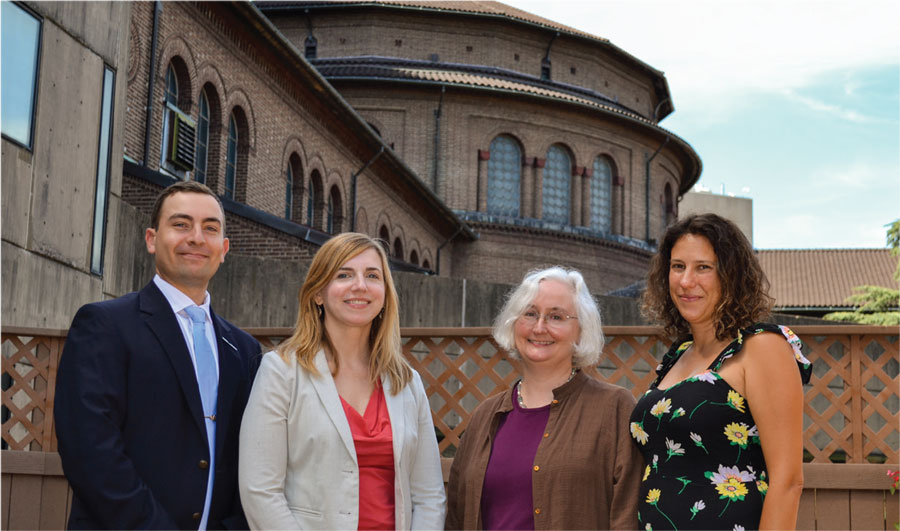THE EASTERN MEDITERRANEAN GALLERY, opened November 19, 2022, celebrates the Penn Museum’s history of excavation and research in the cultural crossroads that includes modern-day Israel, Jordan, the Palestinian territories, Syria, Lebanon, and Cyprus. This special commemorative issue of Expedition includes essays by curators and graduate students that shed new light on this region—from essays about excavations in the 1920s and 1940s to new analyses of “Phoenician” ivories.
Initial discussions about the intellectual trajectory of this gallery came out of a working group in 2016 and 2017 that included professors and researchers from across Penn. Many who contributed to those discussions— including Professors Robert Ousterhout, C. Brian Rose, Thomas Tartaron, and Julia Wilker—broadened the chronological and geographical scope of the project, expanding the focus from the previous “Canaan and Ancient Israel” gallery to the region as a crossroads, encompassing the Eastern Mediterranean from the Late Bronze Age to the Islamic period.

After a hiatus, our curatorial team of four began meeting regularly with Museum staff to plan the gallery in January 2020. Suddenly, a few weeks later, the COVID lockdown barred all of us from the Museum for months and continued to limit access to the objects, archives, and libraries for more than a year. We quickly switched to an online workspace, which worked well for brainstorming, putting together narratives, and working on design, but not for working with and researching objects. The library became available via extended access to digital publications and eventually books by mail. Objects and archives, however, needed other solutions.
We were lucky that Yael Rotem photographed and documented many of the objects in the collection during her curatorial fellowship in 2016–2018. Without her work, it would not have been possible to design this gallery during lockdown. But there were still objects that we needed to see before we could include them in the gallery. Eventually, we came up with a way to do this at one-step removed, with a few pieces at a time. Online study sessions became invaluable. Registrar Elizabeth Caroscio, Near East Section Keeper Katherine Blanchard, and Mediterranean Section Keeper Lynn Makowsky were allowed to come to the Museum a few days a week. They live-streamed objects on Zoom, took measurements, answered our questions, and generally provided key information about the objects. In the Archives, Alessandro Pezzati and Evan Peugh filmed themselves leafing through archival folders so that we could see what they contained and photographed key documents for us. In this way the team devised an enormous list of over 600 objects, which we eventually winnowed down to the approximately 400 objects displayed in the gallery.
One of the co-curators, Joanna Smith, is grateful that she had studied in person many objects related to the Eastern Mediterranean Gallery in years prior to 2020. She had engaged in research projects with the Museum’s collections of Cypriot objects and taught two History of Art seminars in the Museum during 2016 and 2017: one about ancient textiles, the other about a hypothetical Cyprus gallery for the Museum. There are echoes of these seminars in the Eastern Mediterranean Gallery, especially in the displays about sea trade, textiles, copper, and the sanctuary of Apollo at Kourion on Cyprus. All of us are grateful to the graduate students from AAMW, Religious Studies, NELC, and Art History who, with their specializations in periods and cultures across the gallery’s expanded scope, were key to telling the region’s complex story.
Other members of the gallery team faced unusual challenges as well, which they overcame creatively. In Conservation, Jessica Byler and Lynn Grant found ways to document and treat each object despite the closure of their laboratory during the opening months of the pandemic. Similarly, Director of Exhibitions Jessica Bicknell and Director of Preparation Ben Neiditz came up with workarounds when supply chain problems made procuring casework, especially glass, nearly impossible.
The Eastern Mediterranean Gallery showcases a region that has long been a crossroads of diverse peoples and cultures, as well as a center of innovation. Designing this gallery in 2020–2022 brought home to us the significance of connections and creativity in the present and inspired us to look at the past in new ways. The rapid global spread of COVID-19 reinforced how interconnected our modern world is, while the ongoing shortages of goods and of essential workers and their expertise let us see what happens when those connections break down. These conditions encouraged us to improvise and innovate, to find new ways of telling old stories. The Eastern Mediterranean Gallery is a product then of many of the same processes it studies; it would not have been as rich if we had created it during a different time.
We hope you enjoy this issue of Expedition and that you have a chance to visit the new gallery in the coming months.

LAUREN RISTVET PH.D., VIRGINIA HERRMANN PH.D.,
ERIC HUBBARD, JOANNA S. SMITH, PH.D.,
GUEST EDITORS
